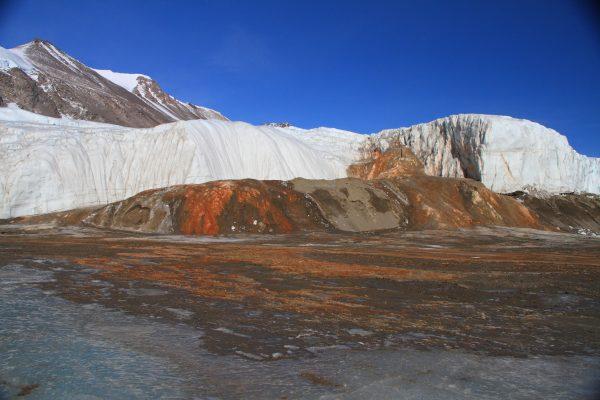
)Erin Pettit / UAF)
Scientists from the University of Alaska Fairbanks and Colorado College have unraveled the mystery of a red waterfall in Antarctica. The research unveils mechanisms potentially at work in other polar glaciers.
University of Alaska Fairbanks glaciologist Erin Pettit led a team that traveled to the bottom of the world to study Blood Falls.
”This features so prominent as the place that everybody knows about. It’s kind of an iconic feature within the landscape that has been a puzzle since the first Antarctic explorers.”
Blood Falls is at the end of the Taylor Glacier, about 30 kilometers from the ocean, an area that was covered by sea water over a million years ago. Pettit said the surface ice of Blood Falls today is salty and iron rich, just like the ancient ocean.
“That was the big puzzle,” Pettit said. “How do you get this salty ice from the bottom up into the glacier and then out the top.”
Pettit said the current project began with earlier research on the Taylor Glacier.
“We had a little bit of data left over from this first project 15 years ago that suggested we might be able to use ground-penetrating radar to study it more,” Pettit said.
UAF PHD candidate Christina Carr said her role in the project was to help operate several of the instruments and make field observations.She said the radar signals sent into the ice did not bounce back but were instead absorbed.
”We interpret this as ice that’s got a lot of salt in it or a lot of little salty pockets of water,” Carr said.
Confirmation of liquid water in such a cold glacier was unprecedented and believed to be the result of its high salt concentration, and energy given off as surrounding ice tries to freeze it.
”It’s just like you have to put heat into water to boil it. If you try to freeze water, you have to take heat out, and that heat has to go somewhere.”
Water is the key mechanism by which glaciers change, and Pettit said the Blood Falls research expands our understanding of its potential.
”(It) basically shows us that water can persist and play this really important role in even the most extreme cold polar environments,” Pettit said.
Pettit sid the next step is trying to understand how pressure differences and crevasses in the ice move water through the glacier. The research project was funded by the National Science Foundation. A paper about the findings is published in the Journal of Glaciology. Its lead author is team member Jessica Badgeley of Colorado College.
Dan Bross is a reporter at KUAC in Fairbanks.




